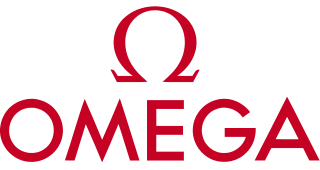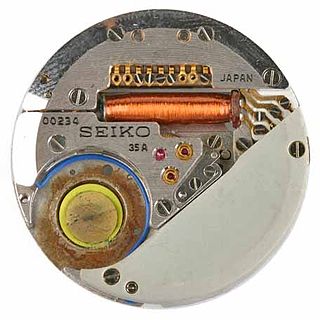
A watch is a portable timepiece intended to be carried or worn by a person. It is designed to keep a consistent movement despite the motions caused by the person's activities. A wristwatch is designed to be worn around the wrist, attached by a watch strap or other type of bracelet, including metal bands, leather straps, or any other kind of bracelet. A pocket watch is designed for a person to carry in a pocket, often attached to a chain.
The Swatch Group Ltd is a Swiss manufacturer of watches and jewellery. The company was founded in 1983 by the merger of ASUAG and SSIH to move to manufacturing quartz-crystal watches to resolve the quartz crisis threatening the traditional Swiss watchmaking industry.
Timex Group USA, Inc. is an American global watch manufacturing company founded in 1854 as the Waterbury Clock Company in Waterbury, Connecticut. In 1944, the company became insolvent but was reformed into Timex Corporation. In 2008, the company was acquired by Timex Group B.V. and was renamed Timex Group USA.

Seiko Group Corporation, commonly known as Seiko, is a Japanese maker of watches, clocks, electronic devices, semiconductors, jewelry, and optical products. Founded in 1881 by Kintarō Hattori in Tokyo, Seiko introduced the world's first commercial quartz wristwatch in 1969.
Bulova is an American timepiece manufacturing company that was founded in 1875 and has been owned by Japanese multinational conglomerate Citizen Watch Co. since 2008. The company makes watches, clocks and accessories, and it is based in New York City.

Omega SA is a Swiss luxury watchmaker based in Biel/Bienne, Switzerland. Founded by Louis Brandt in La Chaux-de-Fonds in 1903, the company formerly operated as La Generale Watch Co. until incorporating the name Omega in 1903, becoming Louis Brandt et Frère-Omega Watch & Co. In 1984, the company officially changed its name to Omega SA and opened its museum in Biel/Bienne to the public. Omega is a subsidiary of The Swatch Group.

Maurice Lacroix is a Swiss luxury watchmaker based in the Canton of Jura and headquartered in Zürich.

The Hamilton Watch Company is a Swiss manufacturer of wristwatches based in Bienne, Switzerland. Founded in 1892 as an American firm, the Hamilton Watch Company ended American manufacture in 1969. Through a series of mergers and acquisitions, the Hamilton Watch Company eventually became integrated into the Swatch Group, the world's largest watch manufacturing and marketing conglomerate.

Poljot, is a brand of Soviet/Russian wristwatches, produced since 1964 by the First Moscow Watch Factory. The flagship brand of the USSR's watch industry, Poljot produced numerous historical watches used in many important space missions, including the world's first space watch worn by Yuri Gagarin.

Citizen Watch Co., Ltd. is an electronics company primarily known for its watches and is the core company of a Japanese global corporate group based in Nishitokyo, Tokyo, Japan. In addition to Citizen brand watches, it is the parent of American watch company Bulova, and is also known for manufacturing small electronic devices such as calculators.

The quartz crisis was the upheaval in the watchmaking industry caused by the advent of quartz watches in the 1970s and early 1980s, that largely replaced mechanical watches around the world. It caused a significant decline of the Swiss watchmaking industry, which chose to remain focused on traditional mechanical watches, while the majority of the world's watch production shifted to Japanese companies such as Seiko, Citizen, and Casio which embraced the new electronic technology.
Miyota is a brand of mechanical and quartz watch movements manufactured by Citizen Watch Manufacturing Co., Ltd. (CWMJ), a subsidiary of Citizen Watch.
Universal Genève SA is a Swiss luxury watch company, founded in 1894 as Universal Watch. Since its beginnings, the company has produced complete watches with in-house movements. Along with neighboring Geneva companies Audemars Piguet, Girard-Perregaux, Patek Philippe and Rolex, Universal is internationally regarded for its style of craftsmanship as a manufacture d'horlogerie. Universal Genève is known for creating the first-ever chronograph in 1917.
Antiquorum is an auctioneer of modern and vintage timepieces. Established in Geneva in 1974, Antiquorum was the first auction house to auction fine watches over the Internet in the 1990s.

The Barrington Griffiths Watch Company, based in Calgary, Alberta, Canada, is a designer and manufacturer of limited edition wristwatches using recycled Swiss movements. The design of their Modern Classic watch was inspired by the 1940s mechanical movement used in its construction. The Barrington Griffiths Watch Company is one of only a few companies making wristwatches in Canada. Although they use movements of Swiss origin, the components of the case are made in Canada, and the watch itself is assembled in Canada, satisfying the Canadian Competition Bureau's requirements for a "Made in Canada" product.

Favre-Leuba is a Swiss manufacturer of luxury wristwatches headquartered in Zug, Switzerland, and formerly a pioneer in watch design, manufacturing and distribution. The foundation of the brand was laid in 1737 when Abraham Favre was registered as a watchmaker, so it has been reported as the second-oldest watch brand in Switzerland, after Blancpain (1735).

Arcadia Watches is a Swiss brand of luxury watches established in 1858. In 1968 the brand ceased following a decline caused by the introduction of quartz movements. It was relaunched in 2007 by Claude Sanz, owner and President of Maison Bunter based in Geneva, and the first new Arcadia watch, the AC01, entered the market in 2010.
US military watches are watches that are issued to US military personnel.

The Omega Electroquartz was introduced in 1969 as the first production Swiss quartz watch. It was the collaboration of 20 Swiss watch companies and the movement was utilised by Rolex, Patek Phillipe and Omega amongst others. The Beta 21 movement used in the Electroquartz was accurate to 5 seconds per month, far better than any automatic or manual wind movement of the day.












